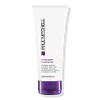What's inside
What's inside
 Key Ingredients
Key Ingredients

 Benefits
Benefits

 Concerns
Concerns

 Ingredients Side-by-side
Ingredients Side-by-side

Water
Skin ConditioningPolyacrylamidomethylpropane Sulfonic Acid
Triethanolamine
BufferingCarbomer
Emulsion StabilisingPropylene Glycol
HumectantVp/Va Copolymer
Hedychium Coronarium Root Extract
MaskingBisamino PEG/PPG-41/3 Aminoethyl Pg-Propyl Dimethicone
Triethyl Citrate
MaskingEthylhexylglycerin
Skin ConditioningPEG-12 Dimethicone
Skin ConditioningLaurtrimonium Chloride
EmulsifyingAminomethyl Propanol
BufferingPolysorbate 20
EmulsifyingSodium Bisulfite
AntioxidantPhenoxyethanol
PreservativeParfum
MaskingHexamethylindanopyran
MaskingTerpineol
MaskingWater, Polyacrylamidomethylpropane Sulfonic Acid, Triethanolamine, Carbomer, Propylene Glycol, Vp/Va Copolymer, Hedychium Coronarium Root Extract, Bisamino PEG/PPG-41/3 Aminoethyl Pg-Propyl Dimethicone, Triethyl Citrate, Ethylhexylglycerin, PEG-12 Dimethicone, Laurtrimonium Chloride, Aminomethyl Propanol, Polysorbate 20, Sodium Bisulfite, Phenoxyethanol, Parfum, Hexamethylindanopyran, Terpineol
Water
Skin ConditioningVp/Va Copolymer
Hydroxyethylcellulose
Emulsion StabilisingTocopherol
AntioxidantCitric Acid
BufferingPhenoxyethanol
PreservativeCitrus Grandis Seed Extract
AstringentParfum
MaskingAloe Barbadensis Leaf Juice
Skin ConditioningHelianthus Annuus Seed Oil
EmollientGlycine Soja Seed Extract
Skin ConditioningBetula Alba Bud Extract
Skin ConditioningMalva Sylvestris Extract
AstringentAchillea Millefolium Extract
CleansingChamomilla Recutita Flower Extract
MaskingEquisetum Arvense Extract
AstringentLavandula Angustifolia Extract
Skin ConditioningRosmarinus Officinalis Leaf Extract
AntimicrobialSalvia Sclarea Extract
AntiseborrhoeicThymus Vulgaris Extract
PerfumingTussilago Farfara Flower Extract
AstringentUrtica Dioica Extract
AstringentWater, Vp/Va Copolymer, Hydroxyethylcellulose, Tocopherol, Citric Acid, Phenoxyethanol, Citrus Grandis Seed Extract, Parfum, Aloe Barbadensis Leaf Juice, Helianthus Annuus Seed Oil, Glycine Soja Seed Extract, Betula Alba Bud Extract, Malva Sylvestris Extract, Achillea Millefolium Extract, Chamomilla Recutita Flower Extract, Equisetum Arvense Extract, Lavandula Angustifolia Extract, Rosmarinus Officinalis Leaf Extract, Salvia Sclarea Extract, Thymus Vulgaris Extract, Tussilago Farfara Flower Extract, Urtica Dioica Extract
 Reviews
Reviews

Ingredients Explained
These ingredients are found in both products.
Ingredients higher up in an ingredient list are typically present in a larger amount.
Parfum is a catch-all term for an ingredient or more that is used to give a scent to products.
Also called "fragrance", this ingredient can be a blend of hundreds of chemicals or plant oils. This means every product with "fragrance" or "parfum" in the ingredients list is a different mixture.
For instance, Habanolide is a proprietary trade name for a specific aroma chemical. When used as a fragrance ingredient in cosmetics, most aroma chemicals fall under the broad labeling category of “FRAGRANCE” or “PARFUM” according to EU and US regulations.
The term 'parfum' or 'fragrance' is not regulated in many countries. In many cases, it is up to the brand to define this term.
For instance, many brands choose to label themselves as "fragrance-free" because they are not using synthetic fragrances. However, their products may still contain ingredients such as essential oils that are considered a fragrance by INCI standards.
One example is Calendula flower extract. Calendula is an essential oil that still imparts a scent or 'fragrance'.
Depending on the blend, the ingredients in the mixture can cause allergies and sensitivities on the skin. Some ingredients that are known EU allergens include linalool and citronellol.
Parfum can also be used to mask or cover an unpleasant scent.
The bottom line is: not all fragrances/parfum/ingredients are created equally. If you are worried about fragrances, we recommend taking a closer look at an ingredient. And of course, we always recommend speaking with a professional.
Learn more about ParfumPhenoxyethanol is a preservative that has germicide, antimicrobial, and aromatic properties. Studies show that phenoxyethanol can prevent microbial growth. By itself, it has a scent that is similar to that of a rose.
It's often used in formulations along with Caprylyl Glycol to preserve the shelf life of products.
We don't have a description for Vp/Va Copolymer yet.
Water. It's the most common cosmetic ingredient of all. You'll usually see it at the top of ingredient lists, meaning that it makes up the largest part of the product.
So why is it so popular? Water most often acts as a solvent - this means that it helps dissolve other ingredients into the formulation.
You'll also recognize water as that liquid we all need to stay alive. If you see this, drink a glass of water. Stay hydrated!
Learn more about Water